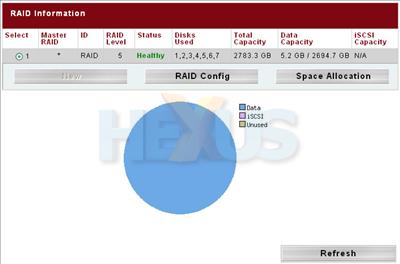Software and features
Keeping things familiar, Thecus' N7700 features the tried-and-trusted web-admin interface. Having evolved over time, it supports useful functionality such as power management scheduling and web-based file access via WebDisk. Remember, though, that WebDisk is restricted to maximum file uploads of 1GB in size.
Not a whole lot has changed in the RAID Information dialogue, but the option for more than one RAID entity could now prove useful in a seven-bay unit.
Disk Information, too, provides all the usual data and is shown above in degraded form.
Perhaps our biggest irritation is the fact that the N7700's audible alarm doesn't deactivate itself until the error it's reporting has been fixed. A useful security measure, perhaps, but we'd like the optional ability to mute the alarm manually.
Media functionality
The N7700 is armed with an arsenal of media goodness, and much of it remains easy to configure and use. We experienced no problems with Photo server and iTunes server, with both functioning as expected and proving easy to use.
Media server, unfortunately, didn't prove to be quite straightforward. We were unable to get it working with Microsoft's Windows Media Player 11, and when switching to CyberLink's SoftDMA, we found it wouldn't list any of our video files.
FTP and BitTorrent access
The N7700's built-in FTP server allows users to upload and download files to the unit over the Internet and is easily configured. Using FTP transfer, we achieved a download speed of approximately 6.5MB/s and an upload speed of 5.5MB/s on a 10/100 connection.
Setting up the N7700's download manager to work with BitTorrent, however, proved to be a challenge. We were unable to get BitTorrent transfers moving, but Thecus advises that the issue should be resolved in the latest N7700 firmware.
In summary, the N7700's feature list is plentiful, but there's still room for greater refinement.











